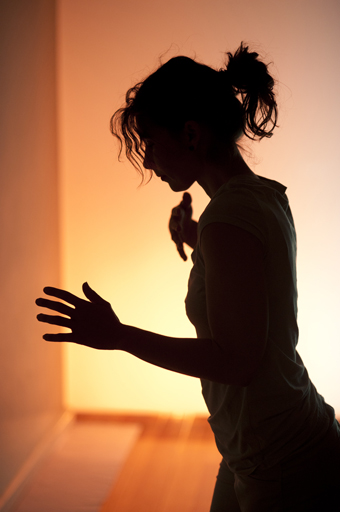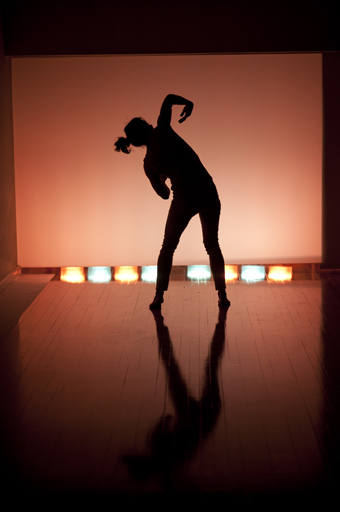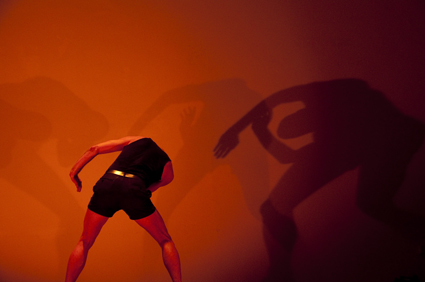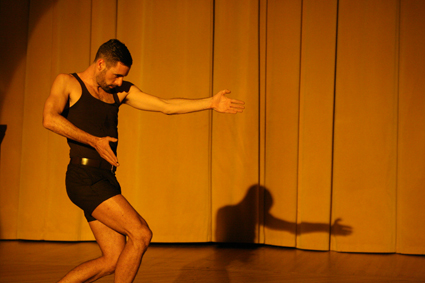 |
Deanne Butterworth, Dual Repérage in Threes photo Rohan Young |
dual repérage in threes
Butterworth’s Dual Repérage in Threes works the length of the venue’s upstairs Studio. To our far right, the choreographer-dancer appears abruptly, in a flurry of extensions, silhouetted in front of a human scale rectangle of bright, softly coloured light. Butterworth’s relationship to this light source is pivotal: she constantly moves away from it to the centre of her stage, sometimes further, only to return to it, sometimes moving backwards into its acute frame. The dancer is not miming push and pull, but the magnetism is evident—sometimes in a mere walk, sometimes as if she’s danced by an unseen force. As if to amplify the work’s anxious, moth-to-a-flame vibrancy, a hand-held torch lightly tracks Butterworth, casting a flickering shadow on the long wall as she moves into the dark.
Michael Munson’s score resonates with the dance; initially short, deep chords and high piano twangs suggest the solidity of acoustic sources, providing a palpable physical sonic pattern against which the dancer’s restive body moves regardless.
As Dual Repérage in Threes evolves, Butterworth’s choreography takes shape, cumulatively building on a calculatedly limited set of movements with occasional, strikingly different images (sculpted posturing, balletic tip-toeing, feet ‘stuttering,’ rapid pelvic thrusts) breaking the routine. The dancing’s not minimalist as in, say, some Molissa Fenley works, but the recurrence and recombination of motifs can be hypnotic or, at times, hard to hold together. Arms lead the body in wide turns, swing over shoulders singly and then together, back and forth at speed; hands spin rapidly over each other; and, in a dominant image, the dancer’s upper body is constantly pulled down towards the floor, centrestage, hands reaching, half-cupped as if something sighted is beyond grasp—the strange potency of this gesture is heightened by the addition of a percussive element to the sound score.
 |
Deanne Butterworth, Dual Repérage in Threes photo Rohan Young |
In the work’s climactic moments, Butterworth returns to the light, a deep musical pulse underlining a frightening escalation of the work’s key motifs—arms and hands spinning, body pulled down and forward over and over. I’m not sure precisely what I witnessed in Dual Repérage in Threes, but Deanne Butterworth’s adroit coding of her choreography (inflected with years of dance know—how, superb balance and rapid gear-shifting) and the work’s near obsessive—compulsive realisation made for a compelling experience.
 |
Matthew Day, Thousands photo Jac Price |
thousands
After I'd seen Thousands during the 2010 Sydney Fringe Festival, I wrote: "We’re seated mere feet away from Matthew Day, alert to the increasing tension in his body as he balances horizontally, close to the harsh floor on a mere two points of contact, suspended for a brief eternity before unfolding into a rotating, standing series of subtle transformations for...I don’t know how long. Time is erased as Day seamlessly mutates into slow-mo, non-literal evocations suggestive of body-builder, dance clubber (bizarrely headless as he faces away from us, head dipped), martial artist, butoh dancer, sportsman... as well as suggesting the body young and then strangely aged. The precision, control and focus are breathtaking. This is not dance in the usual sense, but it takes all the skill, strength and creativity of a talented dancer-choreographer to realise this acutely delineated state of being." (See RT100)
A second viewing of Thousands confirmed for me the work's peculiar, tension-driven power. Day maintains his performance constantly on the pivot of transition, always moving in minimal increments, such that the tension required not to topple or speed up creates a bodily vibration that is at times exhausting to watch but which provides the work with its pulse. This time I was hyper-alert to the meticulous shifts in movement: an arm leads out left, the direction Day is facing, but the palm of the hand faces us while the rest of the body slowly but with determination turns to the right.
 |
Matthew Day,Thousands photo Gareth Hart & Next Wave Festival |
James Brown’s monumental score also generates associations. Its enormous pulsing rumble feels like we’re sitting atop a giant machine, then stuck in a tunnel facing an oncoming train, then the target of hovering helicopters. But Brown’s composition is never literal, its long throbbing, humming lines magnifing the sense of body tension, although not in calculated sync with Day’s staccato internal beat, until the disco passage where music and body become one, Brown making even more of the flying bass lines than usual in that idiom. Of course, Day never deviates from his own pulse, making for some of the most restrained club dancing of all time.
Rosalind Crisp's No one will tell us..., Luke George's NOW NOW NOW and Deanne Butterworth's Dual Repérage in Threes, in their very different ways deliriously engage with the notion of the moment. So does Matthew Day's Thousands, not with improvisation or an open structure as its foundation, but with the 'high-wire' on-the-floor skill of maintaining balance and precision at the slowest of motion in the strangest of dances.
Dance Massive: Double Bill: Dual Repérage in Threes, choreographer, performer Deanne Butterworth, sound design Michael Munson, lighting Rose Connors Dance; Thousands, choreographer, performer Matthew Day, sound James Brown, lighting Travis Hodgson, dramaturgy Martin del Amo, Rebecca Pollard, Yana Taylor; Studio, Dancehouse, Melbourne, March 22, 23; www.dancemassive.com.au
RealTime issue #102 April-May 2011 pg. 18
© Keith Gallasch; for permission to reproduce apply to [email protected]








 back
back